The eggplant, sometimes called brinjal, is a purple color fruit that is utilized in a variety of dishes due to its spongy texture and high-water content. Botanically defined, eggplant is a berry. However, it is more commonly utilized as a vegetable. The skin and seeds of brinjal are edible, like a tomato, although it is typically cooked like a potato. The macronutrient and micronutrient content of brinjal are very low, but its capacity to absorb oils and flavors increases the fruit’s usefulness in cooking.
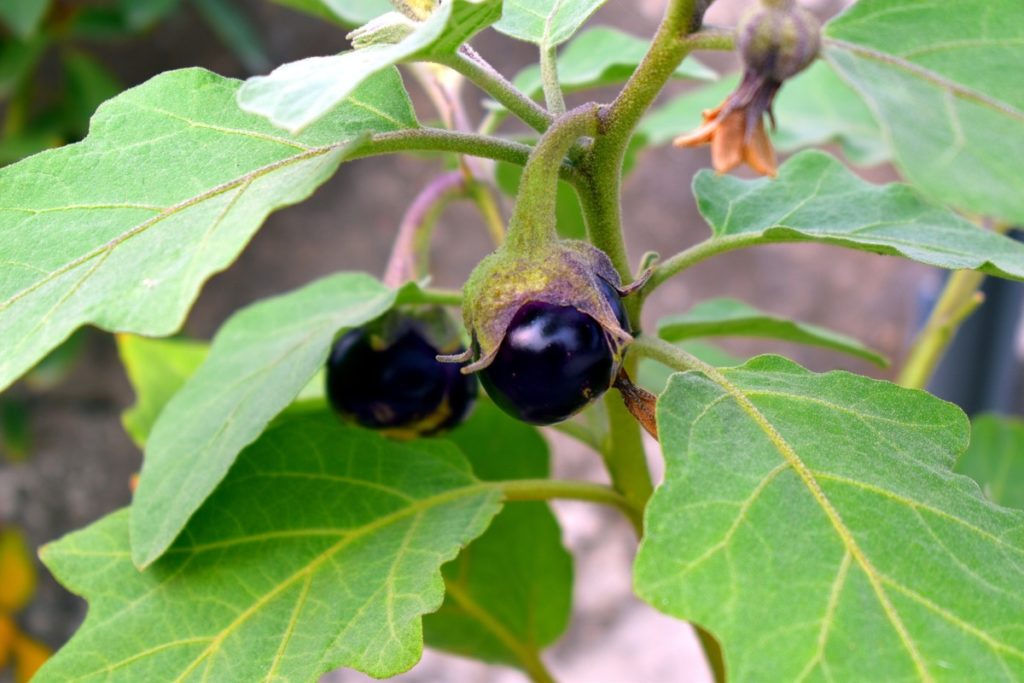
The tropical perennial brinjal plant is treated like a sensitive or half-hardy annual because of its fragility when grown in temperate regions. The flower of a brinjal plant range in color from white to purple and have a corolla with five lobes and one yellow stamen. Some common varieties of brinjal plant produce egg-shaped, glossy, and purple fruit with white flesh and a spongy, “meaty” texture. However, other varieties of brinjal are white and more elongated.
A fully developed brinjal plant can be anywhere from 50 to 150 cm tall, with leaves measuring from 10 to 20 cm in length and 5 to 10 cm in breadth. Large, semi-wild species have recorded leaf sizes of over 30 cm in length and 15 cm in width. Fruit from wild plants rarely exceeds 3 cm in diameter, but that of cultivated variety can reach 30 cm or more in length. The following procedures will provide you with the necessary knowledge for cultivating brinjal successfully in West Bengal.
How to start Brinjal farming/eggplant in West Bengal
Top brinjal producing districts in West Bengal
In India, West Bengal state is responsible for the most brinjal production, followed by the states of Maharashtra and Bihar. Nadia, North 24 Parganas, Hooghly, and Bardhaman, are four of West Bengal’s top producing districts for brinjal. In West Bengal, brinjal is one of the most widely cultivated tropical vegetables.
Countless varieties of brinjal cultivars, each with its unique size, shape, and color, are grown in West Bengal. The nutritional value of brinjal varies greatly from one kind to the next, but they provide a reasonable number of vitamins and minerals, including phosphorus, calcium, and iron.
Different varieties of brinjal in West Bengal
Pusa Shyamal: The Pusa Shyamal is a deep purple cultivar quite long and slightly thick. The Pusa Shyamal hybrid is a fast grower with an early blooming time. Producing in dense clusters of deep purple color, the Pusa Shyamal kind of brinjal weighs approximately 70–80 grams per fruit.
Pusa Purple Long: The pusa purple long variety of brinjal cultivar matures early and produces many fruits. The length of this brinjal type is between 25 and 30 centimeters, and it has a shiny, pale purple color. The crop of pusa purple variety can be harvested after 100–110 days. It can be planted in the summer and the winter seasons and typically produces a harvest of 27.5 t/ha. It is very tolerant regarding shooting borer and minor leaf disease.
Pusa Purple Cluster: The pusa purple cluster is a fast-maturing, high-yielding variety. The brinjal of this kind grows in clusters, is quite small, and has a rich purple color. In 75 days from the transplanting, the crop is ready for harvest. This variety shows little susceptibility to small leaf disease in its natural environment.
Pusa Kranti: The pusa kranti variety is characterized by its short height and spreading nature. The brinjal of this kind are plumper and more rectangular than slim, and they are an appealing dark purple color. Optimal planting times in West Bengal are in the spring and fall. This variety needs about 130-150 days to mature before it can be harvested. A yield of 14-16 t/ha is produced.
In case you missed it: How to Start Eggplant/Brinjal Farming in Malaysia: Check How this Guide Helps to Grow Eggplant
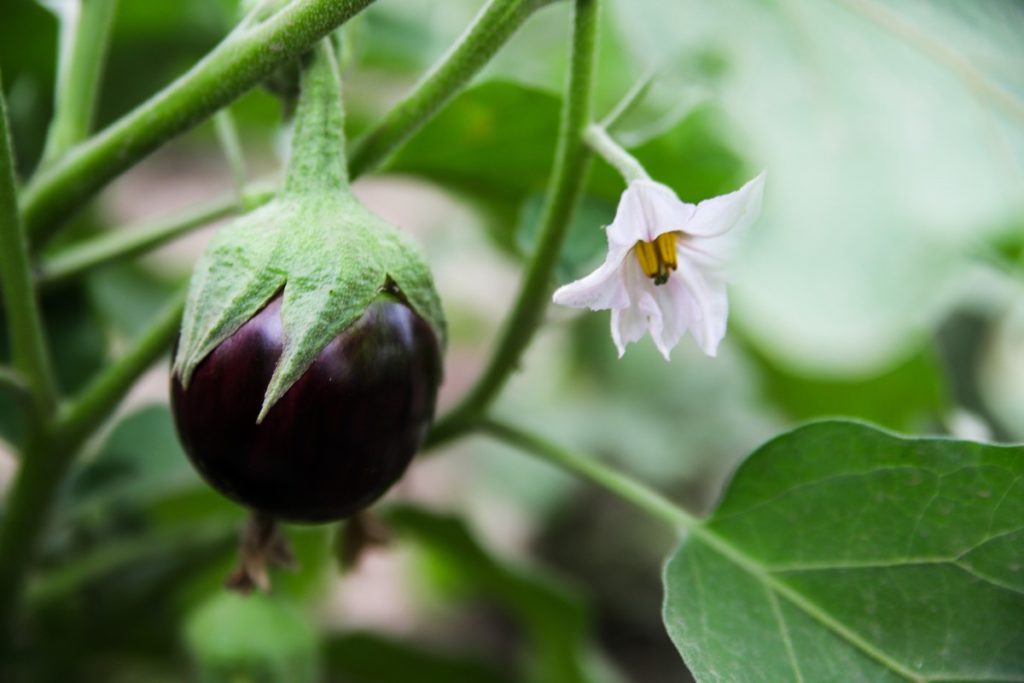
Pusa Ankur: The Pusa Ankur cultivar produces small, oval-round brinjal that is dark purple, glossy, and highly appealing. It’s an early-bearing variety ready for its first harvest 45 days after transplantation. The color and tenderness of its fruits are maintained even after extended harvest periods.
Best season to grow brinjal in West Bengal
In order to flourish, brinjal needs a prolonged period of warm weather. It is very vulnerable to freezing temperatures. The ideal daily mean temperature for its growth in West Bengal is between 13 and 21 degrees Celsius. The crop’s growth will decrease dramatically if the temperature is below 17 degrees Celsius. The brinjal crop does well in both the rainy and the summer months, and it can be planted at an altitude of 1200 meters above sea level.
The Brinjal plant can be cultivated throughout the year, but the rabi season is the most preferred in West Bengal. In the rainy season, the months of June and July are best for cultivating brinjal. October and November are the best for cultivating brinjal in the winter season. And the months of February and March are best for cultivating brinjal in the summer.
Soil preparation for brinjal plant cultivation in West Bengal
Find a site that receives sun all day, then plant your crop there. The temperature must be high for the brinjal plant to grow in a farm setting. It is preferred that brinjal plants need to be placed in a spot where they will get at least six hours of sunlight daily. Even if full sunlight is preferable, eggplants can survive in partial light. Growing eggplants need soil that is both nutrient-rich and well-drained.
Try a test to see how well the soil in your field drains. Fill a hole 12 inches (30 cm) deep and 12 inches (30 cm) wide with water and observe the water’s trail to the surface. It will allow you to make an accurate assessment of the condition of the ground. If water pools and doesn’t disappear within an hour, you know your soil isn’t well-drained. Repair the drainage problems on your farm by mixing some organic soil amendments. You can use a gardening rake to break up the ground’s top 8 inches (or 20 cm).
In case you missed it: Tomato Farming Guide for Beginners: Production Techniques, Process, and Steps
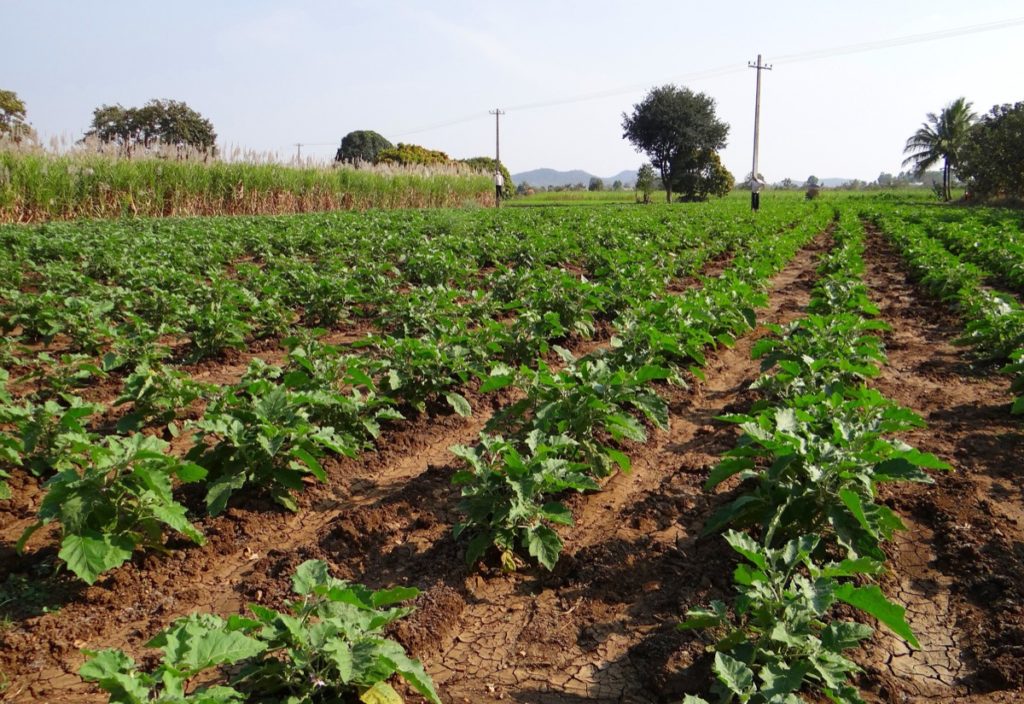
Spread a 2-inch (5.1 cm) layer of an organic soil amendment over the ground. Bury it in with a rake, so it spreads out evenly. It is best to plant your brinjal seeds in potting soil about a quarter of an inch deep for seed germination. And it is best if you dig a hole between 24 to 30 inches deep to sow the brinjal plant seedling. Since brinjal seedlings require a warm environment, they should be started indoors and moved to the garden when the weather permits.
The optimal time to germinate seedlings is six to nine weeks before the last frost. In order to successfully replant brinjal seedlings outside, the average temperature must be above 21 degrees Celsius. To save the trouble of doing all this work from scratch, you can always buy brinjal plant seedlings from a garden center or nursery. The recommended pH value for brinjal cultivation is 5.5 to 6.5.
Seed germination process for brinjal plant
Brinjal seeds have a higher chance of germination if they are soaked the night before planting. To ensure proper germination, soak the seeds until they reach the top of the container. The seeds need to be drained after soaking overnight. Trays with 72 or 128 cells are recommended when planting brinjal seeds since the extra room allows for strong root development. You can get seed planting trays from any garden center or online.
Fill seed trays with fine, aerated, loose organic amendments, then place seeds inside. The best growth medium for brinjal seeds is a potting mix that doesn’t require soil. When sowing seeds, it’s best to fill the tray no more than three-quarters of the way with potting soil. Compost, perlite, vermiculite, and coconut husk are some of the options for potting mix.
Plant the seeds about 0.25 inches deep after watering the soil. Carefully use your fingers to sow a few brinjal seeds in the soil or compost each seed tray. Bury the seeds at a depth of 0.25 inches. Mist or sprinkle the seeds with water to hydrate them. It takes 5-14 days for seeds to germinate after planting. Seeds planted in warm environments can sprout in as little as five days and produce mature plants in as little as two weeks. Increases in temperature reduce the time needed for germination. Keep your brinjal seeds at a constant temperature of at least 18°C while developing.
As soon as the seedlings reach a specific size, you should transfer them to individual containers. Once the seedlings have reached 3 inches, they should be transplanted to individual pots. Fill the pots with the same potting soil or other growing media you used to start the seeds, and place them in the soil. Remove the seedlings from the tray and carefully replant them into new containers. Once the outside temperature reaches at least 21 degrees Celsius, the seedlings in pots can be moved outside.
Number of seeds required for one acre
We typically need between 160 and 200 grams of Brinjal seed to farm one acre of brinjal plant. On average, the cost of seeds required to plant in one acre varies from Rs 1500 to 2000
Spacing of the brinjal seedlings for productivity
Planting brinjal seedlings in a large enough area result in a healthy, flourishing plant. Dig holes a little bigger than the seedlings’ roots and space them 24 to 30 inches in all directions to prepare your planting areas. It is best to provide at least two feet row to row and row to column distance. The seeds should be gently placed in the holes, and the soil should be filled around their stems. To plant seedlings, you must dig a hole at least 24 inches deep.
Providing mulch for brinjal plant
Spreading mulch around your plants’ bases will create a protective layer that will help keep the soil warm and the roots from drying out. Applying mulch around your plants can keep them warmer and lessen the number of weeds you have to pull. Mulch can be provided from several natural resources, including straw, compost, and grass clippings.
They should be applied liberally to the stems and roots of your brinjal plant seedlings. Always use grass cuttings from untreated lawns for mulching to ensure your plants are not exposed to harmful chemicals and fertilizers. A one-inch layer of mulch is recommended for maximum protection around your plants. You can also provide black plastic mulch to your plants that are available at the garden center or online.
In case you missed it: How to Start Dragon Fruit Farming/Pitaya in Thailand: A Step-by-Step Guide for Beginners
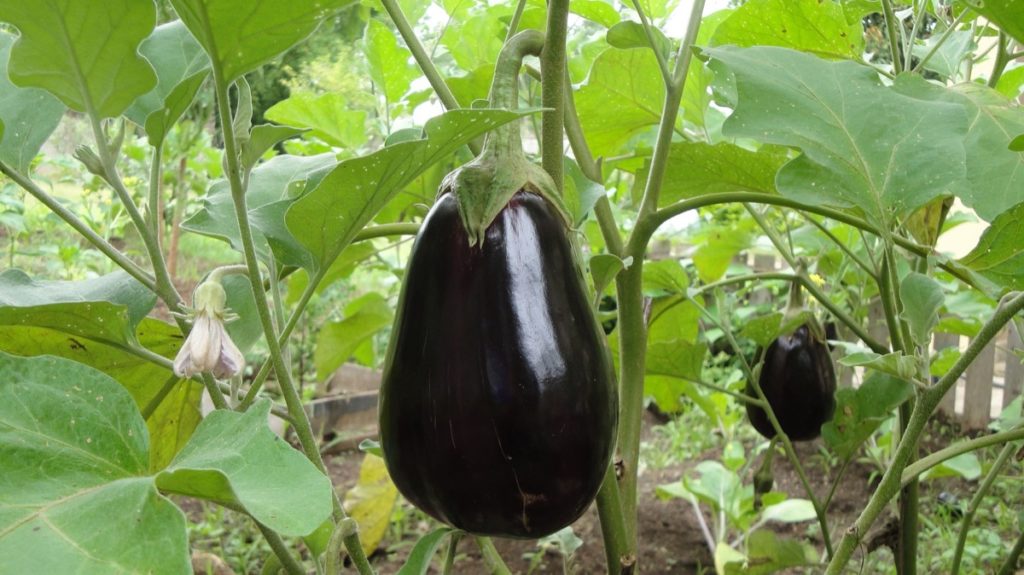
Staking your brinjal plants with sticks
Keep your brinjal plants from falling over by using stakes to hold them straight. Use bamboo canes or other strong poles to support your plants. Insert the stake into the ground about 2 to 5 cm away from the base of a young plant. Plants can lean on the stakes as they grow without damaging nearby plants. Immediately after transplanting your plants, insert the supports to prevent soil disturbance.
Water management for the brinjal plant
Water requirements can differ greatly depending on factors like climate and soil. In general, clay-rich soils need less water for irrigation than sandy soils. And on days when it rains or when the humidity is extremely high, it’s possible that we won’t need to water at all. On the other hand, you may need to water your plants multiple times on a hot, dry day. In addition, there may be a big difference in how much water a given variety of brinjal plant needs compared to another.
In most cases, plants require extra water from the time of pollination to the time of fruit set. Most farmers water their brinjal plants once every three days during the first two weeks of their growth. During the fruit-setting stages and when temperatures increase, watering sessions are lengthened because the plant requires more water than usual. Farmers irrigate the brinjal plants once and sometimes twice a day until the plants reach full maturity.
Drip irrigation for brinjal plants
Among many other irrigation systems, drip irrigation has proven to be the most effective method for watering brinjal plants. Drip lines in commercial agriculture are typically 20 centimeters apart and double or single strips. Drip irrigation uses a system of emitters, tubing, and valves to deliver water to plants.
Drip irrigation systems have the potential to be more efficient for brinjal planting than other types of irrigation systems, but only if they are properly planned, installed, maintained, and operated. The advantage of drip irrigation is it avoids water loss through evaporation by delivering the water directly to the plant’s roots.
Pruning of brinjal plant for productivity
In order to provide growth for new development and prevent harm to the plant, it is necessary to prune your brinjal plant regularly. In addition to protecting the plant against pests, this method encourages the development of the plants and their overall health. If you notice a bud forming on your brinjal plant, pinching it off as soon as possible is helpful. To remove the buds off the stem, pinch them between your fingers.
Doing so will teach the plant to put more energy into developing sturdy stalks and roots rather than producing fruit. In only a few short weeks, your plant will bloom again, and its increased strength will allow it to support large, nutritious fruit. It would be best to remove all dead leaves from the plant’s lower regions.
Removing the plant’s lowest leaves as it develops will help provide optimal fruit production. Next, pinch off the leaves that are right beneath the flowering sections and cut them as close to the stem as possible, either with your fingers or a pair of pruning shears. Pruning helps plants thrive by letting more sunlight and air into their interiors.
In case you missed it: Oklahoma Vegetable Planting Calendar (OK): Month Wise for Fall, Spring, Summer, Winter, Zone 6, Zone 7, and Zone 8
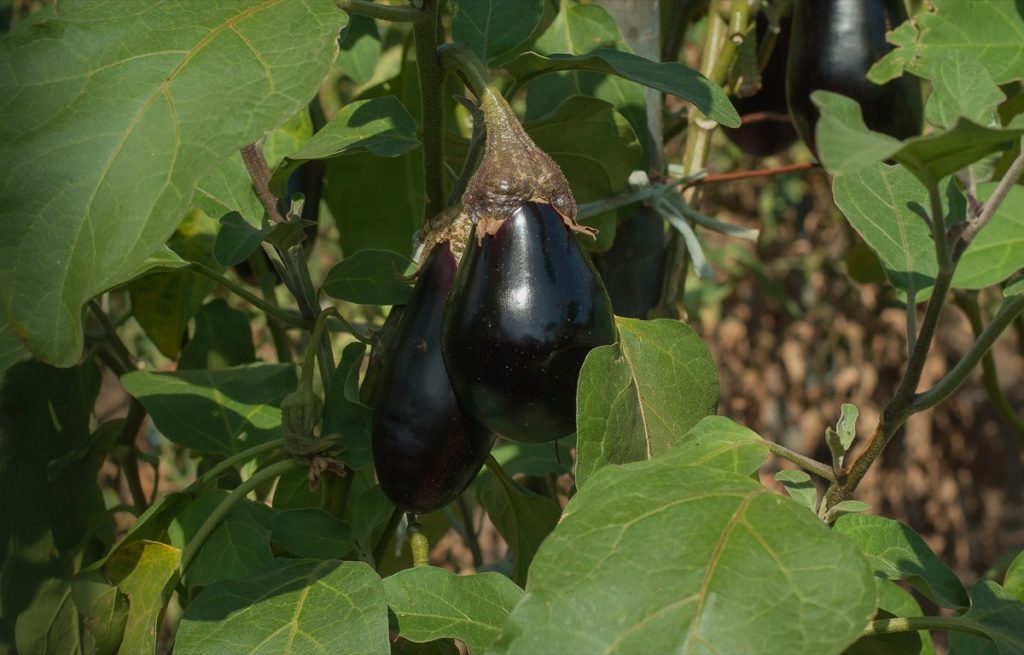
Weeding for productivity
To “weed” a field means to remove weeds or other unwanted plants from it. The development of the brinjal plant can be limited by the presence of weeds since they compete with the primary crop plant for resources like water, sunlight, nutrients, and space. Invasive weeds might also cause a decrease in yield.
If you care about the health of your plants, you should remove weeds as soon as possible. Instead of just pulling the weeds out by their leaves, dig them out completely. If only the top is cut off, the weeds might be able to grow back. If weeds become too problematic, an herbicide can be applied.
Fertilizer management for brinjal cultivation
Fertilizers should only be used after a thorough soil condition assessment, which can be done using semiannual or annual soil testing. Fertigation is the most common method used for fertilizing brinjal plants. Also, farmers often inject water-soluble nutrients into the drip irrigation system. That way, the plant may take its time absorbing the nutrients as they are gradually provided. Professional farmers may use as few as one fertilizer application or as many as ten between planting and harvesting.
Many farmers prepare their rows by spreading well-rotted manure two months before planting. Additionally, high-Phosphorus pre-planting fertilizer is sprayed about a week before planting, and fertigation starts around ten days after planting. During fertigation, a blend of fertilizers high in nitrogen, phosphorous, potassium, and micronutrients is spread over the soil. When plants are exposed to high quantities of phosphorus during the first stages of development, the roots become strong and healthy.
And adding micronutrients aid a plant in recovering from the difficulties of transplanting. Other standard fertilization techniques for the brinjal plant include using urea, potassium nitrate, and ethylenediamine-N. Two to four weeks prior to transplanting, urea is fed into the irrigation system, followed by potassium nitrate six to twelve weeks later, then ethylenediamine-N is provided continuously up until harvest.
However, you shouldn’t rely on them without performing your study, as they are just samples of known patterns. Each agricultural area is unique and has its own set of requirements. It is important to measure the pH level of the soil before beginning any fertilization treatment. The recommended pH value for brinjal cultivation is 5.5 to 6.5.
Pest and disease management for brinjal cultivation
Common pests of the brinjal plant include potato beetles, flea beetles, aphids, whiteflies, and spider mites. Verticillium is the most destructive type of fungus, and it can be prevented only via rigorous sanitation and crop rotation practices. The potato tuber moth primarily feeds on plants from the Solanaceae family. This family includes potatoes, tomatoes, and brinjals. After hatching from eggs placed by adult females, potato tuber moth larvae consume the mesophyll in leaves for survival.
Remove the leaves and flowers immediately if you notice any insect damage. Because of the vulnerability of the brinjal plant to numerous insect and fungal pests, brinjal plants require regular checks for damage. Use row covers to safeguard your brinjal plants. Row covers effectively prevent damage from cold temperatures, disease, and pests while growing brinjal plants.
Row covers are lengthy strips of mesh material used to protect vegetation from predators and other environmental threats. Tuck the ends of the row covers in at both ends of the brinjal plant rows. Then, insert garden pegs into the folded edges using a rubber mallet to secure the covering.
In case you missed it: How to Start Sweet Potato Farming in Asia: A Guide of Cultivation for Beginners

Harvesting
The harvest time for brinjal plants is between 16 and 24 weeks. When the plant reaches the harvesting stage, keep an eye on your brinjal plants every day to prevent them from becoming overly ripe and bitter. Whenever you notice that your brinjal plant is mature enough to harvest, go ahead and harvest it. If you wait a few days, the flavor may turn bitter. Try to find brinjal that has glossy, silky skin. When the fruit’s skin is glossy and smooth, it is ripe and ready to be harvested. The fruit’s skin should be smooth and wrinkle-free.
Different colors in brinjal indicate different stages of maturity, so do some research to find out what color indicates the harvesting stage for your variety. It could be a solid purple color, a purple with white stripes, or a dark purple. The brinjal should be cut close to the stem. A sharp instrument is essential for precise pruning and cutting.
Don’t cut the brinjal stem shorter than one inch from the bottom. A sharp knife or shear is required for slicing through the tough, fibrous stems. Avoid twisting or pulling the brinjal off with your bare hands. You might do damage to the plant if you do that. Brinjals must be stored at about 10 degrees Celsius temperatures to prevent them from losing weight.
Brinjal yield per acre, hectare, and per plant in West Bengal
The production of brinjal crops in West Bengal can change annually from about 8 to 20 tons per acre, depending only on the type of hybrid seeds the farmer chooses to plant. The average yield of the brinjal plant in West Bengal is around 20 to 30 tons per hectare.
The number of eggplants that can be harvested from a single brinjal plant varies with the type of plant. Generally, one brinjal plant can yield up to 15 fruits depending on its variety. Using a total area of 161,000 ha and a productivity rate of 18.42 t/ha, West Bengal harvested 2,965,600 metric tons of brinjal in 2020.
Conclusion
To keep up with rising consumer demand by rising incomes and heightened awareness of the importance of eating healthily, horticultural crop planting in West Bengal is expanding quickly. In West Bengal regions, brinjal, commonly known as eggplant, is one of the most widely farmed vegetable crops worldwide.
It thrives year-round on sandy loam soil between 5.5 and 6.5 on relatively flat terrain. Farmers in the West Bengal area are beginning to cultivate brinjal plants more regularly due to the ease with which brinjal plants can be grown and the rising demand for the brinjal in the market.
- Crops Grown in Summer Season: Best Choices for Summer Gardening
- Organic Pest Control for Tomato Farming
- How to Maximize Sheep Farming Profit
- Broccoli Varieties: Choosing the Right Cultivars for Your Farm
- How to Raise Pigs in Your Own Backyard: A Comprehensive Guide
- Budget Friendly Sheep Shed Ideas: Cheap and Low-Cost Tips
- How Much Do Cattle Farmers Make: Revenue Streams in Cattle Farming
- Management Pests and Diseases in Your Cotton Field
- Sheep Farming Business Plan for Beginners
- Aquaponic Farming at Home: A Step-By-Step Guide
- Profitable Village Farming Business Ideas in 2024
- High-Yield Aquaculture: Fast-Growing Fish for Farming
- Effective Fish Pond Construction Techniques for Beginners
- Irrigation and Water Management in Pineapple Farming
- Blossom to Harvest: Mastering Flowering and Pollination in Papaya Farming
- Pig Fattening Essentials: From Selection to Sale for Beginners
- Raising Wagyu Cattle: A Complete Guide for Premium Beef Production
- Soil Types and Their Water Holding Capacity
- Optimizing Irrigation Schedules for Coconut Groves for Enhanced Yield
- Espresso Your Garden: Coffee Grounds for Healthier Acid-Loving Plants
- The Best Soil Mix for Snake Plants: How to Mix Your Own Snake Plant Soil
- Green Thumb Success: Expert Tips for Cultivating Greenhouse Beans All Year Round
- Bloom All Year Round: The Ultimate Guide to Indoor Hyacinth Care
- Eco-Friendly Gardening: How to Make Liquid Fertilizer from Kitchen Waste
- Ultimate Guide to Grow Anise in Pots: Explore Seed Propagation to Harvesting
- Guide to Raising Chester White Pigs: Discover Breed Facts to Growth Management
- Mastering the Elegance: The Ultimate Guide to Weeping Cherry Tree Care, Planting, and Maintenance
- Ultimate Guide to Planting Garlic in Grow Bags: Growing Strategies for Beginners
- How to Fix Spider Plant Leaf-Related Problems: Natural and Organic Remedies
- 10 Reasons Why Your Tulsi Plant is Shedding Leaves: Home Remedies and Solutions
- Optimizing Growth and Yield: The Advantages of Palm Bunch Ash Fertilizer
- Utilizing Neem Oil Extract as a Natural Pesticide for Hydrangea
- From Soil to Harvest: Various Ways in Which Farmers Can Use AI Tools
- Steps to Encourage and Induce Citrus Flowers: A Comprehensive Guide
- How to Fix Snake Plant Leaf-Related Issues: Natural and Organic Remedies
- Transform Your Garden into a Fragrant Oasis with Raat Ki Rani (Night Blooming Jasmine)
